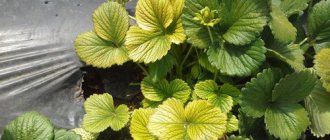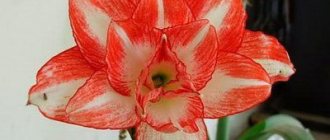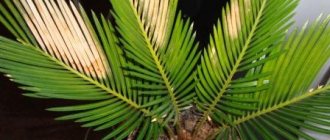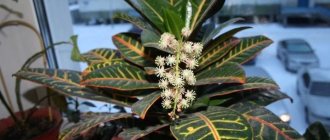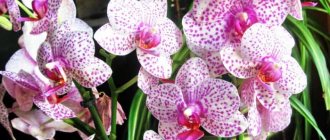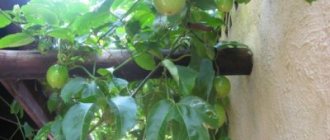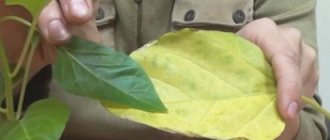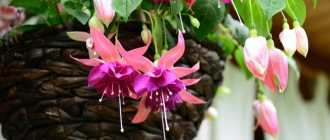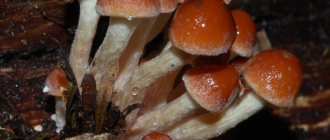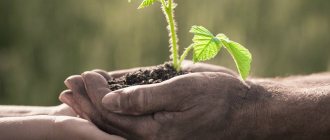Causes of redness
There are quite a few reasons for the appearance of red leaves on strawberries; they can arise both due to improper care of the plantation and plant, and under the influence of pathogenic microorganisms.
Very often, the cause of the formation of red spots on strawberries is an infection. Suspicious is the fact that the leaves do not turn red completely, but selectively and in spots.
If a fungal disease occurs, only treatment with special means will help, because there is no hope that the fungus will freeze out with the onset of cold weather.
Its spores will easily overwinter in the ground, and with the onset of spring warmth they will grow with renewed vigor and will infect the plantation until they populate all the strawberry bushes.
The peak point for the growth of fungal infection is the period of ovary formation on the bushes, which is why there is a significant reduction in yield.
“Chorus” is also considered to be quite effective. To prepare this product, you need to use 12 g of the drug per 10 liters of water. Use the solution to spray plants during the period of active growth of young leaves.
Next, after the bush has faded, you need to make the solution again, but now use 6 g of the product per 10 liters of water and spray again.
Fertilizer shortage
There is a possibility of red spots appearing on strawberry leaves due to a lack of nutrients, this problem is also called nitrogen starvation, so let’s consider what to do in such a situation to preserve the plant.
In order to normalize the condition of the plant and resume its normal nutrition, it is recommended to fertilize with a balanced set that will contain mineral and organic components.
You can prepare such a mixture yourself; to do this, take a third of a bucket of humus and a teaspoon of mineral fertilizer containing potassium in overwhelming quantities. The resulting mixture must be mixed well and the rest of the bucket filled with water.
The liquid will take 3 days to mature and you can start feeding the plant. To fertilize, pour a bucket of water at room temperature and stir 1 liter of prepared fertilizer in it.
Water the strawberries carefully so that the liquid does not get on the bushes. It is recommended to cut off those leaves that have changed color, where young and green leaves will appear in their place.
Thickened plantings
Another common reason for the redness of the foliage part of strawberries is the thickening of the bushes, which occurs if the necessary regular care of the plant is not provided.
In order for the plant to develop normally and bear fruit abundantly, it is necessary to provide it with proper care. To do this, in the spring, all dead parts of the plant should be removed. The area should also be cleared of topsoil. Dig up and loosen the row spacing.
We must not forget about caring for strawberries in the autumn.
Particular attention must be paid to row spacing. The thickening of the planting occurs due to the active growth of strawberry bushes and it simply does not have enough free space
To prevent this from happening, dig up the newly formed bushes and plant them in the right place. This way you will thin out the thickened areas and plant some new bushes, which will soon bring you an additional harvest.
Rules for treating strawberries
Garden strawberries (this is the official name of strawberries) require constant care. A special place in agricultural technology is occupied by the treatment of diseases and pest control of berry bushes. Only a crop that is given time has excellent fruiting.
General rules for the treatment of diseases and pest control consist of the following points:
As soon as the snow melts and the soil begins to warm up, the gardener waters the garden bed with water whose temperature is at least 55 degrees. Boiling water helps get rid of pests and bacteria. It is recommended to prepare a hot solution of manganese. This way the soil will be better disinfected. Treatment with a hot solution of copper sulfate is allowed. The product in an amount of 10 grams is dissolved in a 10-liter bucket of boiling water. You can do without boiling water. Then the strawberry bed is watered with Bordeaux mixture (3%).
Red leaves on strawberry
- Dried or damaged leaves are removed throughout the season.
- Fragrant plants are planted next to the strawberries. Among the popular ones: marigolds, calendula. They will repel pests.
- Diseases are treated with different drugs. For example, wilting can be defeated with the biological product Trichoderma verde. Fruit rot will go away if you transplant the strawberries away from the area with raspberries, spray them before flowering begins, either with an infusion of ash, or an infusion of mustard with garlic, or with the biological fungicide Alirin B.
- When a transparent mite invades, the crop is treated with high temperatures. On a very hot day, the entire strawberry plot is covered with film. A thermometer is placed there. As soon as it reaches +60 degrees, the film can be removed. Next, each bush is cut off, leaving only a small petiole. The leaves are burned.
Note! Aphids, leaf rollers, thrips, and leaf beetles are fought with the help of ash infusion. Alatar is also effective
Why do strawberries have red spots on the leaves?
If the leaves of a crop suddenly begin to turn red in spring or summer, there may be several reasons.
Among the most common:
- The berry plant lacks nutrients;
- The soil is too acidic;
- A fungus settled on the plant, which led to spotting.
Not enough nutrients
Typically, reddening of the foliage indicates nitrogen starvation. In this case, it is worth feeding the plant with nitroammophoska (another name is azophoska), ammonium nitrate.
Azofoska is applied in spring and summer. The month of June will do. It is allowed to embed granules into the soil or dissolve them in water. If the first method is chosen, then 25-35 grams should be scattered per square meter of soil. facilities. Afterwards the garden bed is watered. You can dissolve a matchbox of nitroammophoska granules in a 10-liter bucket of water.
The right time for ammonium nitrate is the first half of the season. It is scattered into shallow trenches between the bushes. Dosage – 10 g. per one square meter.
Another reason for sudden reddening of leaves is a lack of phosphorus. In this case, superphosphate is added. They can treat the bed three times per season. The fertilizer interacts well with organic matter. 35 gr. superphosphate is mixed with a glass of fly ash and a solution of cow manure. Cow dung solution is prepared from 7 liters of water and 1 liter of manure. Such fertilizing will not only provide the crop with phosphorus, but will also make the fruits much sweeter.
Soil too acidic
The foliage may turn red due to increased acidity of the soil. The culture develops normally only in soil whose pH is 6-6.5 pH. Such soil is considered slightly acidic, neutral.
To reduce the acidity of the soil, dolomite flour and ash are embedded in it. Approximately one glass per square meter.
Brown spot
Main article: Brown spots on strawberry leaves
The causative agent of the disease is the Marssonina fungus. Signs of brown spot appear in spring and summer both on leaf blades and on berries. The foliage may become covered with spots, the color of which is red, brick brown, or dark brown. The spots increase in size every day. Brown lesions are visible on berries and stems of the crop. Similar symptoms are observed in the cucumber bed. Cucumber quite often suffers from this disease.
Strawberry brown spot treatment involves both modern and traditional methods:
- If there is a suspicion of a fungal infection, strawberries should be treated with a solution of manganese, as well as Bordeaux mixture (3%).
- Instead of these products, you can take copper oxychloride.
- The disease is treated with systemic contact fungicides Oksikhom, Skor.
It is not recommended to use chemicals during the formation of berries and before harvesting, otherwise strawberries cannot be eaten due to the possibility of poisoning.
The folk method of combating brown spot is to prepare an invigorating cocktail that is destructive to Marssonina mushrooms:
- Take a 10-liter bucket of warm water.
- Add 5 g. potassium permanganate, 4 teaspoons of soda, 10 ml of iodine, 25 gr. laundry soap.
- Everything gets mixed up.
- Each leaf is sprayed with a solution.
This remedy is good because it allows you to fight spotting at any time during the growing season.
You can eat berries after spraying. The main thing is to wash them thoroughly.
If the disease is brown spot on strawberries, then control methods also include:
- Removing and burning damaged leaves.
- Planting bushes is not too dense.
- Keeping the garden clean.
- Treatment with the biological product Fitosporin. It increases the resistance of the crop, has a beneficial effect on growth, and effectively fights bacteria and fungi.
- Watering should be timely, but strawberries should not be overwatered. Like cucumbers, garden strawberries can contract brown spot due to dampness and high humidity.
Causes
Reddening of the leaves can be observed throughout the growing season of strawberry development.
There may be several reasons:
- Lack of nutrition. If strawberries lack certain components, primarily nitrogen, this causes leaf coloration. At the same time, the bush turns red not partially, but entirely, so mineral fertilizers, especially in spring, are very important (if the color is deep red, then there is not enough nitrogen, if there is a purple tint, then phosphorus, and if the leaf is red in the middle and brown at the edges - potassium).
- Brown spot. Strawberries, if not given the recommended care, if they are too thick and too wet, may suffer from fungal diseases. One of the most dangerous among them is brown spot. Small brown spots first appear on the leaves, over time they merge into one large one, then the entire leaf turns red. Outwardly, he appears to be burned. Soon these leaves dry out and fall off.
- Sometimes strawberry leaves may turn red due to unexpected temperature changes and high acidity of the soil.
- Pests. Strawberry leaves may turn red, yellow or purple due to the destructive activity of pests.
- Natural reasons. At the end of summer, when daylight hours shorten, a completely normal destruction of chlorophyll occurs in the leaves. As a result, the old leaves turn red, then the same thing happens to the young ones. As a result, by mid-autumn the main part of the bush turns red. The only exception is the growth point.
This is a completely normal natural process and is not a disease, but it doesn’t hurt to inspect the bushes and make sure that there are no fungal spores or signs of the presence of any pests on the back side.
- https://7ogorod.ru/plodovye-kusty/krasneut-lista-u-klubniki-cto-delat.html
- https://www.dom-v-sadu.ru/pochemu-krasneyut-listya-u-klubniki-1/
- https://countryhouse.pro/pochemu-krasneyut-listya-u-klubniki-chto-delat/
- https://delanadache.ru/krasnye-listya-u-klubniki
- https://frukti-yagodi.ru/pochemu-krasneyut-listya-u-klubniki-prichiny/
Video on how to cure strawberry leaves
In the process of growing strawberries, we are faced with many questions, and one of them is why the leaves of strawberries turn red, is it a disease or a lack of any nutrients? What to do if strawberry leaves turn red?
In this case, you need to determine by the time when the strawberry leaves begin to turn red. On average, the leaves of garden strawberries (strawberries, Victoria) live for 70-90 days. Then they begin to die off naturally. Before this, they turn red and then dry. This process occurs at the end of the summer season.
At the same time, pay attention that if in the center of the bush the leaves are young and green, and on the sides of the berry bushes the old leaves begin to turn red, then your plants feel great and the natural process of dying off the old leaves is underway. In this case, there is no reason to worry about why the lower leaves of strawberries turn red.
How to overcome brown spot on strawberries
To avoid this serious disease, you need to regularly thin out the beds, carry out weeding in a timely manner, and remove diseased and dry leaves. One way to prevent brown spot is to place strawberry beds on a small hill so that the plantings have the opportunity to be well ventilated.
For preventive purposes, before flowering in spring and autumn, after the harvest has already been harvested, the beds should be sprayed with Bordeaux mixture (the solution is prepared according to the instructions on the package, used at the rate of liter per 10 square meters).
If the disease was discovered at the initial stage, it is necessary to mow down all the affected foliage and treat the beds with a weak solution of sulfuric acid. After this, the fungus will die, and the strawberries will sprout and still have time to produce a harvest.
Caring for strawberries and transplanting them to a new place
If you want your strawberries to please you with a good and large harvest in the coming year, then you need to take care of them...
The most effective drugs against spotting are:
- Topsin. It is used for therapeutic and preventive purposes, it “works” for 25 days, then the treatment must be repeated;
- Topaz. Destroys only spores. Can be used even in rainy weather. For preventive purposes, treatment can be carried out in early spring, as soon as the first shoots appear;
- Actellik. The treatment is carried out just before flowering begins. Completely destroys the fungus;
- Discor. Apply only before flowering and after harvest.
All store-bought preparations are prohibited from being used at the fruiting stage. Therefore, during this period it is better to use folk recipes.
Treatment with a rich pink solution of potassium permanganate helps. It can be used throughout the season, but not more than once a week.
You can spray the plantings before flowering with a solution of 30 ml of iodine and 20 g. baking soda to a bucket of water. Before flowering and after fruiting, you can spray, and during the formation of berries, it is better to carefully lubricate the affected leaves with a painting brush.
Tobacco infusion can save strawberries from brown spot. 1.5 kg of dried leaves should be filled with a bucket of water and placed in the sun for two days. Then spray throughout the season.
The same traditional methods can be used if pests appear on strawberries.
Advice!
Tomato tops laid out in beds reliably protect against parasites.
But if there are too many insects, you should buy special preparations:
- Chance. This product helps eliminate weevils and other types of pests. However, this drug has a chemical basis, so it is recommended in cases where the situation is too advanced;
- Fitoverm. It can be used in any weather. Does not harm the environment, is safe for people and animals, affects only insect pests, and does not harm even biologically useful microorganisms in the soil;
- Obkarin. Completely safe for humans. It acts on parasites very quickly. They die literally within 4 hours after tasting such a treat;
- Spark. The drug paralyzes the pests and they soon die naturally. A very effective remedy and affects almost all parasites.
Prevention
It is difficult to find a variety or hybrid form of garden strawberry that is resistant to all diseases. That is why preventive measures and adherence to agricultural practices are so important. Often, gardeners themselves, “forgetting” about weeding, crop rotation, and fertilizer application rates, provoke outbreaks of infections on their own plots.
Recommendations:
- planting healthy strawberry seedlings;
- separate cultivation of different varieties of crops;
- compliance with crop rotation;
- preventive treatments of strawberries in the spring against pests and diseases (biological products, herbal infusions);
- maintaining distances when planting bushes;
- timely weeding and loosening of beds;
- using mulch;
- pruning bushes, mustaches, harvesting plant debris in the fall;
- replacement of planting material every 3-4 years.
Knowledge and adherence to the basics of agricultural technology and crop prevention will protect plantings from insidious diseases. Less hassle and higher yield - isn’t this what all gardeners strive for?
Natalia Severova
Fighting methods
When choosing strawberry seedlings, give preference to local varieties grown in trusted nurseries.
When planting a strawberry plantation, you must give preference to healthy material and a trusted seller. As a rule, garden centers and breeding nurseries jealously monitor the infectious background and will not sacrifice their reputation.
- It would be a good idea to carefully consider the foliage and roots when purchasing, and refuse the purchase at the slightest suspicion.
- The spread of fungi is favored by wet weather and wind.
- Affected foliage must be collected and burned. The whiskers must be removed, and in the year when the fungal infection is rampant, the planting material should not be selected.
- As soon as the crop is harvested, it is necessary to treat the plantation with Bordeaux mixture or a 3% solution of copper sulfate. After 30 days, the treatment should be repeated.
- If last year the strawberry bed was under the control of a fungal infection, then in early spring, treatment is carried out with copper-containing preparations before the period of flower stalks protruding.
Fertilizing strawberries
How to feed strawberries
The first fertilizing of strawberries is carried out in warm weather, after pruning the strawberries and harvesting the area, before the leaves begin to bloom - that is, in April-early May, apply highly diluted bird droppings (1:12) or complex mineral fertilizer - a spoonful of nitroammophoska for 10 liters of water. At the beginning of flowering and fruit ripening, strawberries require more potassium, so fertilizing should consist of an infusion of chicken manure or potassium nitrate; the Kemira-universal complex mineral fertilizer has proven itself very well.
After the strawberry harvest, a fourth feeding is carried out, which accumulates plastic substances for the next harvest. Top dressing should consist of a solution of phosphorus-potassium fertilizers: 30-40 g of superphosphate and 20 g of potassium fertilizer are dissolved in ten liters of water.
Strawberries also need foliar feeding in the form of spraying the leaves in August with a three percent urea solution for successful formation of flower buds for the next year and spraying strawberries four times with a boron solution every 3-4 days during the flowering period - this treatment helps to increase the number of ovaries and the size of future berries.
In addition to the listed fertilizers, in specialized stores you can buy balanced fertilizers developed specifically for strawberries, the use of which increases the yield of the berry by 30%.
Cotoneaster brilliant: description of cultivation Strawberries: cultivation, planting and care
After this article they usually read
Add a comment
Lack of nutrients
In some cases, redness of strawberry leaves indicates a lack of certain nutrients in the soil.
Sometimes the redness of the leaves is a cry for help. The plant signals that there are not enough minerals, or they are there, but are in a form that is inaccessible for absorption.
If the signs are analyzed and no fungal infection is detected, then the strawberry bed turns purple due to phosphorus deficiency.
The element phosphorus is one of the most essential.
It is involved in the synthesis of protein, enzymes and vitamins, and sugar phosphates are formed during photosynthesis, as well as chlorophyll, which is responsible for the green color. Phosphorus is an active participant in respiration and fermentation, energy, nitrogen and carbohydrate metabolism. The energy of the sun is accumulated in leaf plates in phosphate bonds and is used by all cells of the plant body. The absorption of nutrients from the soil, their synthesis and transport to cells also depends on the presence of this element.
To saturate the soil with this element, phosphorus group fertilizers are used.
The process of organic matter production is most intense in young bush cells and is closely related to nitrogen.
Special complex fertilizers contain all the necessary components in certain proportions.
If these elements are not enough, phosphorus can move from older foliage to younger ones. In this case, the leaf loses its green color and becomes red-purple. Taking a closer look at the older leaves, you can see that they are the first to turn scarlet. Initially, redness begins at the edges of large old leaves and gradually spreads to the entire surface.
With a lack of phosphorus, not only does the foliage turn red, but the entire bush slows down its growth, productivity decreases, and the taste of the fruit deteriorates.
Reasons for indigestibility
Any pathology is usually considered comprehensively.
- On the one hand, minerals may not be absorbed because the root system is weak. It is underdeveloped, perhaps due to abnormal weather conditions. Intense heat, lack of watering and rain do not allow young roots to develop. If you dig up a bush and examine the root, it becomes clear that it penetrates very shallowly into the soil, and the scorching sun constantly dries out the soil in its surroundings. Constant moisture, excess rainfall or low-lying plantings lead to the fact that young roots rot, and old ones are no longer able to absorb nutrients.
- The other side is that phosphorus as an element cannot be used by a plant cell without nitrogenous compounds. If from year to year only stove ash is added to the strawberry plantation, without nitrogenous mineral and organic fertilizers, oversaturation occurs, but such phosphorus is not available.
Why do strawberry leaves turn yellow and what to do if strawberry leaves turn yellow.
Quite often in the spring in strawberry beds you can see that the leaves of the strawberries turn yellow, up to a bright lemon color. This is the so-called non-infectious chlorosis.
The reason for its appearance is that the earth warms up much more slowly than the air. And when the sun warms up, most often this is March-April, intensive growth of leaves begins, and the roots, sitting in the cold soil, cannot yet work at full strength and cannot cope with supplying nutrients and moisture to the mountain. This is why strawberry leaves turn yellow.
Another reason for yellow leaves is a lack of iron and improper feeding. The disease is especially severe when the soil dries out.
What to do if strawberry leaves turn yellow?
It is necessary to spray the plantings with preparations containing iron and regular watering, preferably with warm water. Root fertilizing with nitrogen also has a positive effect. You can use ammonium nitrate. The nitrogen it contains helps nourish plants, and ammonia repels cockchafers, which are also the reason why the berry bush in the garden turns yellow and dries.
Strawberry leaves in a small hole
This means that a weevil beetle has settled on your berries, which makes such small holes. If carrots or radishes are planted next to berry bushes, then pests can move from there. In this case, you need to spray the berries before they bloom. Spraying is usually carried out with chemical agents. For example, “Zipershans”, which is dangerous not only for strawberry pests, but also for earthworms and birds. Therefore, it is better to use biological preparations against the weevil, which makes small holes on strawberry leaves. This is Iskra - bio, Akarin, Fitoverm.
The weevil is also the reason why strawberry leaves dry out. It overwinters in strawberry leaves and begins to feed on the juice of young leaves in early spring. Therefore, if the leaves of a strawberry dry and you notice a dried bud on the stalk, then it is too late to fight the pest. He flew to raspberries, and will return to strawberries again for the winter. The berries need to be treated in early spring, or when the buds have not yet emerged and the temperature remains at 8 - 10 degrees, with one of the indicated preparations. In the case of the weevil, the good news is that it never completely eats the entire berry crop.
Preparing Strawberry Leaves
The foliage must be prepared before the flowering period and berry ripening begins. It is at this moment that a large amount of nutrients and beneficial substances is concentrated in the leaves. They are prepared together with the petioles and laid out in the shade to dry. You can grind it before or after drying.
It is possible to use strawberry leaves using another type of herb. Grind leaves and herbs, add berries to them, pour boiling water and brew. You can drink strawberry leaf tea throughout the day.
Strawberries have beneficial properties and contraindications. If you have at least one of these diseases, the use of berries and leaves is not recommended:
- Hypersensitivity to berries or pollen,
- ulcer,
- high acidity,
- hypertension.
It is better not to self-medicate, as this may worsen the patient’s condition. Therefore, if you feel unwell, you need to contact a specialist.
There are several conditions that can cause harm to the body:
- if you have gum disease or have dentures, berry seeds can cause discomfort,
- berries rot quickly, spoiled fruits can cause poisoning,
- The use of nitrates for rapid fruit growth is not allowed. This has a negative effect on the body,
- It is better to choose a local type of strawberry, excluding blue or multi-colored berries brought from other countries.
You should eat berries grown in your home or proven garden. Then strawberries will benefit the body and strengthen the immune system.
Causes of redness of strawberry leaves
It is difficult to make a diagnosis in absentia, but by describing the reasons, you can try to guide the gardener to those signs whose appearance is especially characteristic.
Only in autumn can reddening of strawberry leaves be a natural process, with the leaves evenly changing their color. But if the redness begins with some spots, this is already a sign of the disease.
Redness of the leaves can occur with:
- lesions by microscopic fungi;
- mineral deficiency.
Whatever the reason, there cannot be one symptom of “leaf redness”. As a rule, any change entails a whole chain, so for a complete diagnosis it is necessary to conduct a thorough examination of not only the leaves (young and old) but also the berries, buds, peduncles, root system, and also evaluate the intensity of growth.
This is what healthy foliage looks like on a strawberry.
If there is also a strawberry bed in the neighborhood, it would be a good idea to compare the condition of the foliage and other signs on it.
Microscopic mushrooms
There are many microscopic fungi that, under appropriate natural and climatic conditions, acquire pathogenic forms and cause diseases.
Brown spot
Brown spot can affect the leaves, petioles and runners of strawberries.
Initially settling on the leaves, the fungus forms red-brown spots with a purple or burgundy frame. Over time, the spots merge, and the strawberry plantation acquires an increasingly reddish-brown “tan.”
The fungus affects not only foliage, but also leaf petioles and tendrils. If you look closely at the affected leaves, you can see dark, black dots on them.
Another damaged strawberry leaf.
The fungus overwinters well on affected plants.
Brown spot
Brown spot begins with small dots and spots that merge as the disease progresses until the entire leaf turns brownish-brown.
The fungus that causes this disease rarely affects petioles and runners; their tissue is “hard,” but the leaf blade suffers more.
In this case, the spots are first red-purple, then they become brown. You can see with your own eyes how a red plantation turns into a brown one.
White spot
The first symptoms of the disease appear in the spring, usually peaking at the beginning of the harvest.
It would seem, what is the connection between red foliage and white spotting? However, with this disease, the fungus behaves in such a way that red-brown spots appear on the foliage, framed by a dark red rim. Merging, they make the leaf purple. Then the spots turn white, and the leaves become whitish after turning red.
Verticillium wilt
The work of this mushroom becomes especially noticeable during the period of budding and fruiting. Old leaves lie on the soil, as if covering it, turn red and wither. Young leaves become pale, lose their gloss, and become smaller.
The growth of the bushes stops, and the bushes gradually begin to die. If such a bush is removed from the ground, you will find that the root system is quite damaged.
Why do strawberry leaves turn red?
- If red leaves on strawberries appear in the very middle of summer, this is due to too high acidity of the soil.
- Also, red leaves on strawberries and wild strawberries indicate nitrogen
- Red-purple strawberry leaves warn of a lack of phosphorus.
- If only the edges of the leaves are red and then turn brown, then this is a lack of potassium.
Causes of rusty spots on strawberry leaves
You can often notice yellow spots on the inside of a strawberry leaf. As a rule, they have a round or oval shape. At first the spots are small and noticeable. But if the disease is not noticed in time, it will progress.
Over time, the stains will acquire a rusty color and become voluminous. In appearance, this mushroom is very similar to mold, only with a distinct bright tint.
Here are clear signs of rust fungus. If left untreated, the orange papules will begin to grow together, completely covering the leaf and taking all the nutrients from the plant. As a result, the leaves will fall off and the strawberry bush will die.
Rust mushroom on a strawberry leaf.
What to do?
- Spread plastic film under the affected bush. This will prevent the spores from spreading and getting onto strong, healthy plants;
- Put on gloves and carefully cut off all diseased leaves (at the root);
- After the procedure, be sure to burn the leaves away from the area.
Diseased leaves need to be cut off at the root.
Drugs
After all the procedures, it is necessary to treat the strawberry bushes with special preparations. Among them may be: “Titan”, “Agromedicine”, “Baktofit” and others.
Many gardeners note the greater effectiveness of fungicides. But remember, they are not always safe. For example, fungicides of chemical origin contain mercury and copper, which can cause harm to human health. Therefore, it is better to take a closer look at organic, natural substances. To protect strawberries from rust, you can take preventive measures, for example, treat the plant with Bordeaux mixture every spring
It is important to maintain concentration (no more than 1%).
The drug Agrolekar is suitable for treating bushes.
It is best to carry out the procedure in April or early May, after flowering begins.
The danger of bird droppings
It is important! Many gardeners add bird droppings to fertilize the soil. In the case of strawberries, this is not the best option; the fertilizer may contain spores of fungal diseases
It is better to use rotted manure.
Bird droppings should not be used as fertilizer.
Why do brown spots occur?
Brown spots on strawberries are not uncommon. They appear in the middle of the leaf, gradually starting to grow. You may notice that the spots begin to change color, turning into dark brown and black.
Most likely, the plant became infected with anthracnose. The insidiousness of the disease is that if it is not eliminated, the strawberries will be affected and the bush will eventually die completely.
Strawberries infected with anthracnose
This disease is most often observed in greenhouses and greenhouses, where favorable conditions are created for the proliferation of fungal spores.
Fighting stains
What to do if a problem is detected:
- Remove affected leaves;
- Be sure to treat the plant with special preparations: “Metaxil”, “Signum”, “Anthracol”.
To process strawberries, you can use the drug Metaxil.
It is important! The plant can be saved only at the initial stage of the disease, when only the leaves are affected. If spots appear on inflorescences or fruits, it is better to get rid of this strawberry bush.
Prevention
Don't forget about preventive measures. In spring, you can treat the bushes with Bordeaux mixture (3% concentration). You can also use the preparations “Jet” and “Cumulus”.
Cumulus is one of the means used for prevention.
Control and prevention measures
In order to provide the plant with good nutrition, growing conditions and reduce the risk of late blight or completely destroy the fungus, gardeners need to:
- carefully inspect seedlings for diseases;
- plant plants on well-lit, non-oxidized and protected from the wind land plots;
- regularly water, loosen and feed strawberries with natural (ash, manure) and industrial mineral fertilizers (phosphorus, potassium, nitrogen or complex: Nitrophos, Ammophos and others) during the period before flowering and fruit set, as well as as needed (if there are signs of mineral deficiency ) and during the fruiting phase;
- cut off the changed lower leaves, remove and burn diseased strawberries;
- use special preparations before the period of active growth of strawberry foliage (Bordeaux mixture, Fitosporin, Zircon, etc.), and if diseases develop, spray at any time.
- Before planting strawberry seedlings in acidic soils, it is necessary to lime them, i.e. add lime.
- in regions with low average daily temperatures, it is recommended to cover the strawberry beds with plastic film or spandbond at night;
- Wood shavings, which must be scattered in the root zone of the berry bush, will help rid the soil of excess moisture.
How to prevent damage using agronomic methods
- An important criterion for a good harvest is the choice of healthy seedlings of good quality. You can prepare planting material yourself; this will take 2–3 years. In this case, the mustache can only be cut off from bushes that are free of diseases. The advantage of the method is that the seedlings do not need to be stored; they are immediately planted in a permanent place. In garden centers or nurseries, it is better to purchase material in containers with a closed root system. This increases stress resistance during the establishment period, which means the plant is less susceptible to the influence of unfavorable factors.
- You should not plant young plants where infected strawberries grew. It is better to observe crop rotation. It’s good if garlic, onions, marigolds, and petunias grew in this place before. Next time, it is better to plant strawberries in the same bed after 3–4 years.
- The risk of infection is reduced when strawberries are planted in a cozy place protected from the wind.
- Properly prepared soil affects the general condition of the crop. The structure is sandy loam or light loam, the pH level is 5.7-6.2, that is, the acidity is as close as possible to neutral.
Tip #1. It is important to maintain optimal acidity. If the indicators are less than specified, this will lead to intensive growth of fungal microorganisms.
- The plant’s immunity will be enhanced by proper nutrition, which is provided before planting. In each hole you need to place 2 handfuls of humus from one ash. Everything needs to be thoroughly mixed with the soil.
- Before planting, it is better to soak bushes with bare roots in a solution of potassium permanganate (potassium permanganate) for two hours. It is important to dry the plant before placing it in the ground. For good rooting, the main root is pinched and excess leaves are torn off, leaving 3 to 4 young leaves.
- To reduce the likelihood of infection, it is better to plant strawberries on black spunbond.
Spunbond is a material that will protect strawberry bushes from infection from the soil.
Lack of nutrition (red, purple leaves)
Another reason for the redness of strawberry leaves, and in this case it is not just some small part that turns red (for example, in the form of a spot), but the entire leaf or a large part of it, is the lack of a certain nutrient in the soil.
The change in color in the case of “starvation” occurs due to the destruction of chlorophyll in the leaf tissues.
Important! A deficiency of a certain nutrient can be caused not only by its absence in the soil, but also by a deficiency of another element, thanks to which the first is absorbed. Thus, a lack of nitrogen most often occurs due to a deficiency of phosphorus in the soil, and a lack of iron manifests itself, for example, in the case of an excess of calcium in the soil
Nitrogen
If strawberry leaves begin to turn red in the summer, this clearly indicates a lack of nitrogen.
What to do if strawberry leaves turn red due to lack of nitrogen?
Of course, feed with nitrogen fertilizers:
Mineral: urea/urea (20-30 grams per 10 liters of water) or ammonium nitrate (30 grams per 10 liters).
Phosphorus
Strawberry leaves are small (shrinking)…
and purple color is a clear sign of phosphorus deficiency.
In other words, you need to fertilize strawberries with phosphorus fertilizer:
potassium monophosphate (20-30 grams per 10 liters);
Video: how to properly feed strawberries with superphosphate in spring
Immediate application of appropriate fertilizers helps to eliminate the visual symptoms of nutritional deficiency, improves plant growth and fruiting, but will never reach the same level as plants that do not suffer from nutritional deficiency to the same extent.
Potassium
In case of potassium deficiency, strawberry leaves turn red around the edges (they acquire a red-brown border).
What potash fertilizer should I use to feed strawberries if the edges of their leaves turn red?
potassium humate (potassium + trace elements);
Microelements (calcium and magnesium)
Also, strawberry leaves can be colored differently in red or brown shades in case of a lack of certain microelements:
calcium;
What does the appearance of red spots indicate?
If red spots appear on the leaves, which over time acquire a darker, richer shade, this may indicate that the strawberry is infected with a brown fungus.
Fungal spores do not overwinter in the soil, but prefer to do so in fallen leaves, which is why it is important to tidy up the area before the onset of the autumn-winter season.
The fungus begins to actively manifest itself in warm, damp weather. According to calendar dates, this is usually the beginning of May. But the plant is also more likely to get sick in early to mid-September, when heavy rains are added to high air temperatures.
When spores fall on strawberry leaves, they form small red dots on their surface. Over time, they grow and have no form as such. The spots begin to turn purple, but if you look closely, there will be small dark spots on the leaves, which are where the spores are located.
How to help strawberries?
If the strawberry leaves turn red around the edges, or even the central parts are already being captured, then you need to take care of feeding. Unfortunately, it will no longer be possible to achieve high yields this year, but this is an investment for the next season. Phosphorus starvation can be restored, but it takes time. As soon as a change in color is noticed, action should be taken.
If it is spring, fertilize with nitrogen during the growing season of young foliage or the beginning of summer. To do this, it is enough to make a solution of pig, cow or horse manure 1:10 or bird droppings 1:20. If organic matter is not available, then use 1 tbsp. a spoonful of ammonium nitrate in a bucket of water. 0.5 liters are added to each bush. There should be 3-4 feedings with an interval of 12-15 days. The last fertilizing with nitrogen is carried out during the period of extension of flower stalks. If autumn has arrived, we do not use nitrogen, but make a note for spring.
If the spring is dry and the summer is hot, then watering is the most necessary measure. There should always be moisture under the strawberry bush, in the area of the root system. Daily sprinkling, watering at the root or installing a drip system are the keys to the productivity and health of a strawberry plantation.
Balanced, timely nutrition, regular watering will make the strawberry bed green, clean, and healthy. Not only the health of the bushes, but also the taste of the berries themselves depends on the well-being of the plantings.
Types of fertilizers for strawberries
You can grow a good harvest only on strong, healthy bushes. It is much easier to carry out preventive feeding and treatment than to completely destroy the disease-affected bed and re-grow the strawberry plantation. For normal growth and absorption of nutrients, a strong root system must be formed. Its growth and development is ensured by a complex of fertilizers, which includes:
- organic;
- mineral;
- complex;
- WMD;
- microfertilizers.
- Each species is needed by the plant at one time or another.
Minerals are divided into:
- Nitrogen - calcium and ammonium nitrate, ammonia, urea, ammonium sulfate.
- Potassium - potassium sulfate, potassium nitrate.
- Phosphorus - superphosphate, potassium monophosphate.
Complex fertilizers are formulated according to the 3 in 1 principle, diluted in a ratio of 1 teaspoon per 10 liters of water, solution consumption - 0.5 liters. per plant.
Microfertilizers help absorb the necessary elements:
- iron;
- magnesium;
- copper;
- boron;
- zinc.
The most popular drugs are Quantum, Helatin strawberry, and Oracle.
Method of application: spray on leaf plates. Beds with strawberries will always delight you with a harvest if you take care of them in time. To guarantee a good harvest, you need to carefully select material for new plantings, carry out fertilizing and preventive spraying, regularly apply ash between the rows, and water only at the root of the bush.
Inspecting the leaves once every 2 weeks will help warn about the onset of the disease; special attention is paid to the uniformity and richness of leaf color, the absence of small dark spots, and good leaf tone. Attention should be paid to monitoring timely replacement in accordance with the natural rhythm, removing excess tendrils and rooting new rosettes intended for planting in August. Simple and effective measures will keep the plantings healthy, and observations will tell you whether the leaves are turning red due to a normal change in the life cycle or are signaling that help is needed.
White spots
If white spots appear on strawberry fruits and leaves, this indicates that the plant has become infected with white rot. This disease rarely kills strawberries, but it can destroy the fruit very quickly. White rot should not be confused with ramularia.
Causes
White spots usually indicate that the plant is suffering from white rot. This disorder is also caused by fungi, and infection usually occurs in the summer and at the end of May, when the air weather stabilizes at +25 degrees and above.
Please note that white rot is characterized by the appearance of a specific white and gray coating; if there is no plaque, but there are brown spots, then this indicates that the plant is suffering from remularia, and not white rot
Signs
The main sign of the disease is the appearance of a white or gray coating on the leaves and fruits. The fungus feeds primarily on fruits, and without treatment, the fungus destroys the crop in 5-10 days.
Please note that some people confuse white rot with remularia, but distinguishing these two diseases is very simple: in the case of white rot, a characteristic white coating forms on the surface of the fruit, which can be scraped off with a fingernail; with remularia, there is no coating, and the leaves are colored not only white , but also brown, and the fungus affects the shoots and roots
Danger
White rot is dangerous because it can destroy a strawberry crop in a short time.
Please note that the disease rarely affects shoots and roots, so white rot rarely destroys the plants themselves
The white rot fungus exists in the form of spores in winter, spring and autumn, and in warm rainy weather it awakens, which leads to very rapid infection of strawberries.
What to do?
For treatment, it is necessary to carry out therapeutic spraying with fungicides. A good drug against white rot is Derosal or its analogues. For treatment, you need to dilute 10 ml of the medicine in 10 liters of water, and you need to spray the whole plant.
It is recommended to spray the entire garden, since the fungus is easily carried by the wind from one plant to another. It is also necessary to remove affected strawberries, since strawberries with a white fungal coating are unsuitable for consumption.
In case of heavy rains, infection with white rot can lead to rotting of leaves and shoots - in this case, it is recommended to uproot the strawberry bush and burn it.
Prevention measures
To prevent white rot from appearing, you need to adhere to the following preventive measures:
- Periodically, preventive spraying of the plant should be carried out using the fungicide Derozal (its analogues are also suitable). For preventive spraying, it is recommended to dilute 5 ml of the drug in 10 liters of water.
- If it often rains while growing strawberries, then it is recommended to cover the strawberries with film to reduce soil moisture, since the white rot fungus really likes waterlogged soil.
- Before planting strawberries, you need to dig up the soil well so that during watering the water does not stagnate in the soil.
Brown spots: how to fight fungus?
Brown spots can often be found on strawberry leaves. They are circular in shape and have a small diameter . Fungal spores spread very quickly; in just a week, all leaves can become “spotted.”
The disease does not end there. The center of the spot begins to lighten and white dots appear. As a rule, the leaf rots in this place and a hole forms.
This plant lesion is caused by the fungus Ramularia tulasnei. The disease is called white spotting. If it is not eliminated in time, the leaves of the plant will die, and the spores will spread to the stems and root system.
Strawberry leaves have white spots.
Drugs
You can fight the fungus with Ridomil and Euparen .
The drug Ridomil destroys the fungus on the plant.
Causes of redness of leaves
Before you sound the alarm and run to the store for medications, you need to find out the reason for the color change. If (soon) the leaves begin to turn red at the end of the season, then there is no reason for trouble. This is a normal process of aging and death. The leaf lives on average 70-90 days. A little later, the bush begins to change its leaf mass; new leaves emerge from the middle, which will go under the snow and protect the root system in frosts. There is no need to treat the bush for natural reasons, but if such a scene is observed in the middle of summer, especially during the flowering period, this is still a pathology.
Lack of substances in the soil
Carefully examining the shade of the leaf, (God) ordered to make assumptions about the composition of the soil:
- monochromatic red - increased subacidity of the soil;
- red petiole - lack of nitrogen;
- violet tint - phosphorus starvation;
- brown drying edges of reddened leaves are a signal of potassium deficiency.
There is almost no clear indication from above of a specific cause; combined symptoms are more common.
Similar to how to do
In order to preserve the bushes and maintain their strength, feeding is necessary. The lack of nitrogen is compensated for by ammonium nitrate, scattered between the rows of salina, and combined nitrogen-based fertilizers.
Phosphorus is necessary for synthesis in the northern forests; its lack is fraught with underdevelopment of the plant and its disease. If there is a deficiency of the element, it is difficult to absorb nutrients from the soil, which causes the leaves to change color to red. Fields) superphosphate, potassium monophosphate will help. They are applied when watering at the rate of 3-4 liters of solution per 1 sq.m.
Before transplanting strawberries to a new place, sowing green manure, for example, mustard, peas, millet, and rape, is a good help. The crop is sown in early July, in the middle the majestic bed is dug up along with the seedlings, enriching and disinfecting the soil. Then you can plant strawberry bushes and expect healthy bushes and a bountiful harvest of large berries for the next year.
The action of green manure is based on bringing the soil into a balanced state by selective action. In addition, the bottom becomes light, breathable, and enriched with organic substances, micro and macroelements. It is especially beneficial to sow after harvesting, while there is time before frost.
Must take into account:
sowing green manure reduces the number of weeds on the site.
Legumes, cruciferous plants, cereals, buckwheat, amaranth, and hydrophilic plants are used for planting.
Fungal infections
They cause the development of brown and white spotting and verticillium wilt. There are no words in all cases, the first signs are spots on the leaves, initially single, but gradually covering the entire surface, right down to the petiole. The letter is a threat to the entire plant and its close neighbors, since the fungus is very resistant to external conditions and moves to healthy bushes without looking back.
Fighting methods
First of all, dried, affected leaves are removed and burned. You can’t leave them piled up. The fungus will successfully overwinter on them and next year will continue its destructive activity. Sometimes diseased bushes have to atrophy completely, the infection descends on the root system and almost turns it into dust. To treat the disease, strawberries are sprayed with Topaz, or Bordeaux mixture.
Important: fungal diseases are very difficult to cure; they cling to the slightest opportunity to return to the bush. To ensure planting safety for the following year, you should:
- Carefully inspect the bushes intended to avoid replanting, and at the slightest suspicion destroy without regret.
- The mustache is cut to pieces and burned along with the affected leaves.
- The release material is not taken from a bed with diseased plants.
- After picking the berries, the entire plantation is treated twice with 3% copper sulfate or Bordeaux mixture for prevention, with a break of a month.
Features of strawberry diseases
Diseases to which strawberries are susceptible are classified into three main groups:
- fungal;
- bacterial;
- viral.
Most often, strawberry plantations are affected by pathogenic fungi that find themselves in conditions favorable for development and reproduction (extreme heat or little sun, high humidity, dense plantings). The fight against them is not always successful and takes a lot of effort and time.
Viral infections related to quarantine diseases and requiring special protection and prevention measures are not uncommon. Bacterial diseases, fortunately, are less common, but it is also necessary to know about them.
